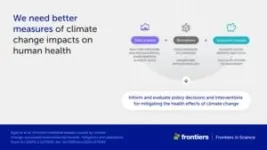(Press-News.org) A research group coordinated by the University of Helsinki was able to measure a spike in radiocarbon concentration of trees in Lapland that occurred after the Carrington flare. This discovery helps to prepare for dangerous solar storms.
The Carrington Event of 1859 is one of the largest recorded solar storms in the last two centuries. It was seen as white light flares on a giant sunspot group, fires at telegraph stations and disturbances in geomagnetic measurements, as well as aurorae even in tropical regions.
In a joint study carried out by the University of Helsinki, Natural Resources Institute Finland and the University of Oulu, a sign of an increase in radiocarbon concentrations following the Carrington storm was detected for the first time in tree rings. Previously, radiocarbon traces have only been detected from far more intense solar storms.
Discovery through a cosmic marker
Encounters between strong magnetised clouds of charged particles released from the Sun, known as solar plasma flows, and Earth’s geomagnetic field result in geomagnetic storms. The geomagnetic field directs the solar storm particles into the atmosphere primarily through the Polar regions. The most visible consequence of the phenomenon are aurorae.
In the upper atmosphere, sufficiently high-energy particles can, through nuclear reactions, also produce radiocarbon (14C), a radioactive isotope of carbon. Over the course of months and years, radiocarbon ends up in the lower atmosphere as part of atmospheric carbon dioxide, and eventually in plants through photosynthesis. The process of photosynthesis preserves the information contained in carbon dioxide in the annual rings of trees.
To obtain the information held by radiocarbon, samples are extracted by carving from the wood material grown over individual years. The samples are processed to cellulose and the cellulose into pure carbon by burning and chemical reduction. The fraction of radiocarbon in pure carbon is measured using a particle accelerator.
“Radiocarbon is like a cosmic marker describing phenomena associated with Earth, the solar system and outer space,” says Markku Oinonen, Director of the University of Helsinki’s Laboratory of Chronology, who headed the study.
Mapping solar storms
A solar storms corresponding to the Carrington event in modern times would disrupt electrical and mobile networks and cause major problems for satellite and navigation systems, leading to problems in, for example, air traffic. This is why accurate knowledge of solar behaviour benefits society.
Solar storms smaller and more common than the Carrington storms can be studied with measuring devices and satellites nowadays, while larger ones can be investigated, for example, by measuring radiocarbon concentration in tree rings.
So far, it has not been possible to study specifically medium-sized storms such as the Carrington event, which have not occurred in modern times, using conventional radiocarbon techniques. This recent study opens up a potential new way of investigating the frequency of Carrington-sized storms, which may help to better prepare for future threats.
Increasingly accurate information on the carbon cycle
The results were interpreted using a numerical model of radiocarbon production and transport developed by researchers at the University of Oulu.
“The dynamic atmospheric carbon transport model was specifically developed for describing geographical differences in the distribution of radiocarbon in the atmosphere,” says Postdoctoral Researcher Kseniia Golubenko from the University of Oulu.
What was significant in the recently published study was how the radiocarbon content of trees in Lapland differed from that of trees at lower latitudes. The first measurements were carried out at the Accelerator Laboratory of the University of Helsinki, while repeat measurements conducted in two other laboratories significantly reduced the previous uncertainties.
The discovery can help to better understand atmospheric dynamics and the carbon cycle from the time before human-generated fossil fuel emissions, enabling the development of increasingly detailed carbon cycle models.
“It’s possible that the excess of radiocarbon caused by the solar flare was primarily transported to the lower atmosphere through northern regions, contrary to the general understanding of its movement,” muses Doctoral Researcher Joonas Uusitalo from the Laboratory of Chronology.
Other sources of radiocarbon
“It’s also possible that the cyclic change in the production of radiocarbon in the upper atmosphere caused by the variation in solar activity has resulted in the local differences on the ground level seen in our findings,” Uusitalo adds.
According to Uusitalo, the dominant fraction of radiocarbon is produced by galactic cosmic rays coming from outside the solar system, even though exceptionally strong solar storms generate individual bursts of the isotope in the atmosphere. Cosmic rays, in turn, are weakened by solar wind, a continuous flux of particles originating in the Sun that fluctuates between stronger and weaker in 11-year cycles.
The topic requires further research. Historical records show that significant geomagnetic storms also took place in 1730 and 1770, which is why their tracking is likely to be in focus next.
The recently published study was carried out as a collaborative project of the University of Helsinki’s Laboratory of Chronology and Department of Physics, and Natural Resources Institute Finland. Researchers from the University of Oulu, Nagoya University, Yamagata University and ETH Zurich also contributed to the study. The study received funding from the Research Council of Finland, the Finnish Cultural Foundation and the Emil Aaltonen Foundation.
Original article: Joonas Uusitalo, Kseniia Golubenko, Laura Arppe, Nicolas Brehm, Thomas Hackman, Hisashi Hayakawa, Samuli Helama, Kenichiro Mizohata, Fusa Miyake, Harri Mäkinen, Pekka Nöjd, Eija Tanskanen, Fuyuki Tokanai, Eugene Rozanov, Lukas Wacker, Ilya Usoskin, Markku Oinonen. Transient Offset in 14C After the Carrington Event Recorded by Polar Tree Rings. AGU, 2024. DOI: 10.1029/2023GL106632
Further information
Joonas Uusitalo, Doctoral Researcher
University of Helsinki
joonas.uusitalo@helsinki.fi
+358 45 886 4698
Thomas Hackman, University Researcher
University of Helsinki
thomas.hackman@helsinki.fi
+358 50 448 6258
Markku Oinonen, Director of Laboratory
University of Helsinki
markku.j.oinonen@helsinki.fi
+358 50 318 7302
Kseniia Golubenko, Postdoctoral Researcher
University of Oulu
kseniia.golubenko@oulu.fi
+358 44 950 7665
Ilya Usoskin, Professor
University of Oulu
ilya.usoskin@oulu.fi
+358 50 344 1247
Samuli Helama, Senior Scientist
Natural Resources Institute Finland
samuli.helama@luke.fi
+358 2953 25047
END
Tracing the largest solar storm in modern times from tree rings in Lapland
2024-04-04
ELSE PRESS RELEASES FROM THIS DATE:
Shy sea anemones are more likely to survive heatwaves
2024-04-04
Even in nature, pride can prevail. A study with researchers from the University of Gothenburg shows that sea anemones that react more slowly to change can survive a heatwave better than individuals that change their behaviour quickly.
Along the Atlantic coasts of Europe, many species are exposed to abrupt shifts in habitat. Tides, storms and rapid temperature changes are commonplace for the marine species that live there. With climate change, heatwaves are expected to become more frequent, and researchers wanted to find out how coastal marine species cope with extreme water temperatures. They chose to study the sea anemone species Actinia ...
Researchers at UMass Amherst are listening in on the world’s rulers—insects—to better gauge environmental health
2024-04-04
AMHERST, Mass. – Recent research led by the University of Massachusetts Amherst evaluates how well machine learning can identify different insect species by their sound, from malaria-carrying mosquitoes and grain-hungry weevils to crop-pollinating bees and sap-sucking cicadas. Listening in on the insect world gives us a way to monitor how populations of insects are shifting, and so can tell us about the overall health of the environment. The study, published in the Journal of Applied Ecology, suggests that machine and deep learning are becoming the gold standards for automated ...
Climate change impacts terrorist activity
2024-04-04
Changing weather patterns induced by climate change are contributing to shifts in the location of terrorist activity, according to new research.
An exploratory study led by extremism expert Dr Jared Dmello, from the University of Adelaide’s School of Social Sciences, found some climatological variables affected terrorist activity in India.
“Suitability analyses indicate that all the climatological variables tested – temperature, precipitation, and elevation – relate to shifting patterns of terrorist activity,” says Dr Dmello.
“Urban centres have increasingly grown in population ...
Exercise habits in youth create better health outcomes for some
2024-04-04
Forming a long-term recreational exercise habit as a young person has a beneficial impact on physical and mental health later in life, but some groups, such as females and academic high-achievers, miss out on these benefits disproportionately.
A University of Adelaide study found females, people with low self-efficacy, reluctant exercisers, higher academic achievers, and those experiencing socioeconomic disadvantage are all most at risk of failing to establish regular exercise patterns during the transition from adolescence to young adulthood.
The finding was made by examining data collected as part of the Longitudinal Survey of Australian ...
Researchers uncover a potential method for interrupting the misfolding of tau protein that underlies neurodegenerative disease
2024-04-04
(Santa Barbara, Calif.) — A spectrum of neurodegenerative diseases, including frontotemporal dementia (FTD), progressive supranuclear palsy (PSP) and corticobasal degeneration (CBD) are due to the accumulation of abnormal, misfolded tau proteins in the brain. A team of researchers led by UC Santa Barbara scientists has found potential ways to interrupt this process by targeting “sticky” sites along the long form of mutated tau, preventing the misfolding and spreading of the neurofibrillary tangles.
“This is ...
UT Health San Antonio establishes Be Well Institute on Substance Use and Related Disorders
2024-04-04
SAN ANTONIO, April 3, 2024 – The University of Texas Health Science Center at San Antonio (UT Health San Antonio) is establishing the Be Well Institute on Substance Use and Related Disorders, a pioneering initiative dedicated to advancing research, education and evidence-based treatments.
The new institute includes the current Be Well Texas initiative of UT Health San Antonio as part of a new overall comprehensive center of excellence with national scope for research, clinical and public health programs, as well as education and community engagement to advance the field addressing addiction and related conditions.
The goal of the Be Well Institute is to be a nationally premiere substance ...
Study finds high amounts of silica exposure in previously deployed military veterans
2024-04-04
Since the conflicts that followed 9/11 in 2001, military veterans deployed to areas in Southwest Asia, Iraq, Afghanistan, and the Horn of Africa have been developing respiratory diseases caused by inhaling particulate matter linked to their deployment locations and job duties. New research published in the International Journal of Environmental Research and Public Health shows levels of silica and other silicates are significantly higher in the lungs of those who have had past deployments compared to normal lung tissue.
“Using ...
Life expectancy increased as world addressed major killers including diarrhea, lower respiratory infections, and stroke
2024-04-04
Global life expectancy increased by 6.2 years since 1990 according to a new study published in The Lancet. Over the past three decades, reductions in death from leading killers fueled this progress, including diarrhea and lower respiratory infections, as well as stroke and ischemic heart disease. When the COVID-19 pandemic arrived in 2020, however, it derailed progress in many locations. This is the first study to compare deaths from COVID-19 to deaths from other causes globally.
Despite the challenges presented by the COVID-19 pandemic, the researchers found that the super-region of Southeast Asia, East Asia, and Oceania had the largest net ...
Research shows direct link between state income taxes and migration
2024-04-04
After the introduction of the income tax in the United States, there has been a migration of higher income earners toward states with lower or no income tax, a new study reveals.
This first-ever systematic analysis of 110 years of state income tax implementation throughout the United States also highlights the consequences of taxpayers fleeing to low or no-tax states. Published in the American Economic Journal: Economic Policy, the study is titled “The Introduction of the Income Tax, Fiscal Capacity, and Migration: Evidence from U.S. States” and was coauthored by Ugo Antonio Troiano, economist and associate ...
SynGAP Research Fund (SRF) appoints Kathryn Helde, PhD, as Chief Scientific Officer (CSO) focusing on SYNGAP1 research
2024-04-04
Mill Valley, CA – April 4, 2024 – SynGAP Research Fund 501(c)(3), the leading patient advocacy group working to improve the lives of SYNGAP1-Related Disorder (SRD) patients, today announced the appointment of Kathryn Helde, PhD, as its Chief Scientific Officer, effective February 1, 2024.
“SRF’s scientific grantmaking, industry partnerships, and repurposing efforts have grown past the point where we need a dedicated CSO,” says Mike Graglia, SRF’s Co-Founder and Managing Director. “We are fortunate to have a parent in our ranks who is as well trained, talented, and dedicated as Dr. Helde. As a volunteer for years, ...







